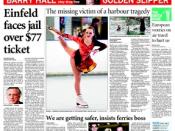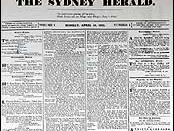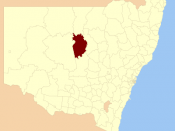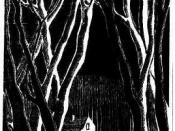'Bogan' is a term used in New Zealand and Australia to describe a subgroup, one distinguished by their low socio-economic status, lack of education, obnoxious loudness and crassness (often displayed in public places), less than savoury personal hygiene and questionable attire, and their particular affinity toward Holdens or similar vehicles, music of the heavy metal or rock persuasion, rampant sexual activity, football and other forms of sport, and alcohol consumption and/or drug use.iThis report will attempt to examine the portrayal of the bogan subgroup in the media, using three texts. These texts are; 'Perhaps there's a little bogan in everyone'ii, a newspaper article in the Sydney Morning Herald, Trent From Punchyiii, an excerpt from an unfinished documentary, and the Last Train To Freoiv, a film. The three texts will be hitherto referred to as 'Perhaps', 'Trent', and 'Freo'.
Representation; A common ground.
In all three of the texts, bogans are portrayed in a similar fashion.
Undesirable, and stupid. In Perhaps, the common bogan is described as "...embarrassing and "un-Australian", and instantly, recognisably 'hyper-Australian'". In Trent from Punchy, no description is needed. Trent, the young man being interviewed, makes him self look uneducated, stupid and undesirable merely by talking- he epitomises the ideal of the 'Australian bogan' with every word he says- from the battle cry of "coppers, coppers (policemen)- punch 'em in the face!" to the concession he makes, telling us that his mother is, in fact, a 'dickhead'.
Furthermore, there are parallels which can be drawn between the three texts, in representing the lifestyle of the bogan. In Perhaps, bogans, or the bogan subgroup which the article is about (cashed up bogans, or cubs) have a particular interest in buying various materialistic things- one of which is fast cars. In Trent, Trent expresses his taste for fast cars, talking about "the boys doing max doughies n' shit[sic] in the gravel near Lincoln Station".
Despite the previously outlined inclination toward automobiles, it seems to be a characteristic of the common bogan that they are often found upon public transport. This particular stereotype may be due to the fact that a person who is not normally affiliated with bogan-kind is likely only to encounter them on trains, or buses. This example is made glaringly obvious by the setting of Freo- namely; a train. This is furthered by the motive of the characters David and Lisa- who, in an attempt to observe the behaviour and interaction of the common bogan, deliberately set out on the journey from Midland to Fremantle- knowing that it was highly likely that there would be boganic folk present on a train at midnight. This 'frequenting of public transport' stereotype is also shown in Trent- it states at the beginning of the video clip that they discovered Trent at Punchbowl Train Station in Victoria.
Representation; Breaking The Mold.
In Perhaps, the bogans being written about differ in the sense that they are not economically hindered. They are 'cashed up bogans'. Bogans with money. This seems to demolish the crux, the very core of what boganity is spawned from and depends upon. Logically, the main cause of the bogan subgroup is a lack of fiscal wealth. Bogans are looked down upon in society as they lack the vague, minuscule amount of class that is required to fit in within Australian society as an equal, not a member of the lower class. This lack of refinery stems from their lack of wealth. Without wealth, the common, or soon-to-be bogan cannot afford to live in one of the 'leafy-green' suburbs such as Nedlands or City Beach and instead must dwell in a suburb such as Midland (which the two 'bogan characters', Trev and the Tall Thug in Freo, ironically enough, hail from). In these areas there is less access to good public schools (which perhaps could be considered an oxymoron in itself), and the bogan family is surrounded by people in similar circumstances- a writhing mass of boganimous cohabitation.
Due to the previous observations made, it seems strange to suggest that a wealthy person could be considered a bogan. However, because it is possible to do so, this tells us that the main classifying factor in relation to bogans, is the attitude. The crass, loud, 'in your face' attitude. An Australian can enjoy beer, 'footy' and Holdens whilst still retaining his or her composure. It is the loss of this rather limited composure that truly makes the bogan. This is discussed further in the article Perhaps.
In Freo there are two characters who could be considered 'bogan'- Trev and the Tall Thug. Trev is more your stereotypical bogan, not indifferent to Trent in terms of manner. The Tall Thug, however, differs from the typical bogan image presented. He enjoys Vivaldi. He has been to Prague. He is intelligent and enjoys ruthless psychological control over people. He doesn't fit the image of the typical gormless bogan, whereas his companion Trev fits that description perfectly.
Codes and Conventions, Constraints and Audience Profiling.
The article Perhaps uses a technique to both draw the reader in, and set the angle of the story in an instant. This is done by the wording of the headline, being, 'Perhaps there's a little bogan in everyone'. This both intrigues and insults the reader. It intrigues the reader, as upon reading such a title they instantly begin to wonder as to how they are in fact, a bogan. Secondly, they become somewhat insulted by the suggestion that they might in fact, be a bogan. This shows the opinion which the Sydney Morning Herald has on bogans. The Sydney Morning Herald and its viewers who are mostly middle to upper-class people, the bourgeois, do not like bogans, and do not enjoy being likened to bogans. Bogans are portrayed as something distasteful, something which a person would be ashamed to be called. The readers of the Sydney Morning Herald value affluence, class and composure- all things which bogans are not, or do not have. The text Perhaps further reinforces the opinion that readers of the Sydney Morning Herald already have of the bogan subgroup, helping to further widen the class divide.
In the text Trent, a similar attitude is conveyed. This is shown through the written title at the beginning of the video. The writing reads 'This is actually a kid we found at punchbowl station'. This immediately sets the mood for the viewer. The sense of disbelief that it implies paints Trent as some sort of carnival animal to be gawked at and ridiculed (which of course, is the intent of the video). It sets the bogan group aside from the general population, making them a subgroup that most viewers feel they can distance themselves from by assuming a superior air. Overly-exaggerated examples of bogans like Trent make the bogan stereotype seem absurd, laughable. It seems unfathomable that somebody can proclaim that "...girls are bitches, they're like stitches. You pull 'em out and they.....open up!" in all seriousness. Trent may be a real person, being interviewed spontaneously, but he is so far removed from normality that it is easy to classify all bogans in the same category and differentiate oneself from them entirely. Trent may not have a specified target audience, but the video is spun so that anybody who watches it will feel as if they are 'above' Trent. The viewers of Trent see bogans in a negative light. The producers of the text is a 28 year old named Macca. A typical Aussie male who, like his viewers, considers himself above bogan culture. By exploiting Trent and making the video, his motive clearly came through- to make people laugh at Trent, and in the same process, elevate his social status. The makers of the film were constrained only by the guidelines of Youtube and by their lack of professional video equipment.
The Last Train To Freo is the only fictional text, and also the only text which attempts to explore the man behind the bogan. The character the Tall Thug has more to him than his jailbird past. He is cunning, callous and manipulative. He is also homosexual, which breaks away from the stereotype of bogans being homophobic. Freo explores the social issues behind the drug abuse and bogan lifestyle adopted by many members of the working class. The producers behind the text were concerned with the social class issues in Australian, particularly Western Australian society. They wished to empathise with the lower classes, not to ridicule them. The film was constrained by a small budget, and by the fact that it was adapted from a play and thus filmed almost entirely in one carriage on a Perth train.
ContextAll three of the texts are wholly Australian. They use Australian slang, Australian cultural references, even real Australian settings, such as Punchbowl Train Station and the Midland to Fremantle train line. This helps to bring a sense of reality to the texts, so Australian viewers can comprehend the texts well. A foreigner viewer may not understand some of the uniquely Australian references made in the texts- for example, the picture of Kath and Kim accompanying the article Perhaps may be seemingly irrelevant to an outsider, whereas an Australian would understand that Kath and Kim serve to represent, or rather, epitomize the 'cashed up bogan' lifestyle.
ConclusionFrom studying the texts it can be noted that many media representations portray bogans in a wholly negative light, and serve to further ostracise and isolate them from the rest of society. It seems ironic that the only fictional text which was analyzed was the only text which attempted to break past the societal barriers, stereotypes and taboos and actually examine the character of the person behind the bogan facade. It can be gathered from this, that the majority of Australian society has a negative view of bogans.
Information for definition gleaned from 'Ultimate Bogan Resources'. Bogan.com. 15th March, 2007Perhaps there's a little bogan in everyone. The Sydney Morning Herald. June 8th, 2006.
Trent From Punchy. Youtube.com February 1st, 2008.
The Last Train To Freo. Jeremy Sims. 2006.





